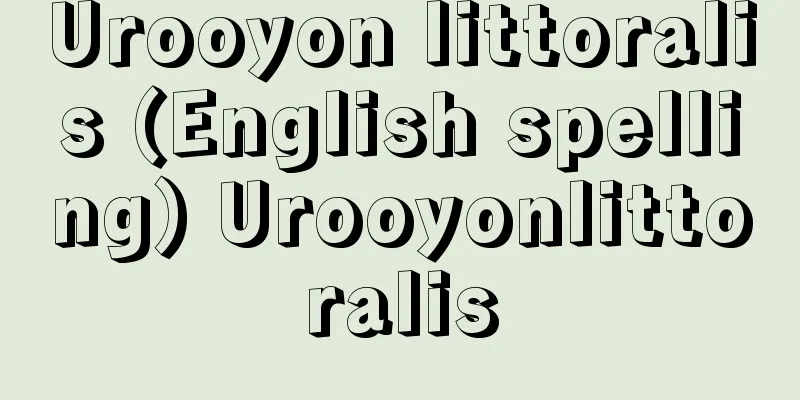Transplant - Ishoku

|
It refers to the process of separating an individual or part of a tissue from an organism and transferring it to another location in order to allow it to survive or grow in a new organic environment. In this case, the individual providing the transplant or graft is called the donor, and the individual receiving the transplant or graft is called the recipient. Depending on the conditions of the transplant, it can be classified as autotransplantation, homotransplantation (transferring a part of the same individual to another), allotransplantation (transferring to another individual of the same species), or xenotransplantation (transferring to an individual of a different species). Generally, the difficulty of transplantation increases in the above order. There are also cases where the transplant or graft is transplanted to the same site on the recipient (orthotopic transplantation) and cases where it is transplanted to a different site (displaced transplantation). In addition, transplantation also refers to placing a piece of tissue or a cell mass from a microorganism or organism on a culture medium (explant) or transferring it to another culture medium, and is used as a tool or material in biological and medical research. [Sadao Yasugi] Animal transplantationIn zoology, in order to understand the function of a certain organ, it is common to transplant the organ into another individual and study its effects. This method is particularly effective for organs that produce humoral factors such as hormones. Also, in experiments, parts of early developing embryos in multicellular animals are transferred to different environments to study their developmental fate and differentiation ability during embryogenesis. Nuclear transplantation, in which the nucleus is extracted from a cell and transferred to another cell (usually a cell that has been made non-nuclear), is performed to study the relationship between the nucleus and the cytoplasm. Nuclear transplantation techniques are also often used to create cloned animals. Transplantation has become an important treatment in modern medicine. Skin and cornea transplants have been performed since ancient times, but since the latter half of the 20th century, transplants of organs essential for survival, such as the heart, liver, and lungs, have also been performed. In these cases, the biggest problem is overcoming the immune rejection reaction, but the development of excellent immunosuppressants such as cyclosporine and FK506 has improved the results of transplants dramatically. Currently, the ethical issues associated with transplants are being debated in society, especially the extent to which living donor transplants are permissible and how to determine brain death in the case of transplants from deceased donors. In Japan, the Organ Transplant Law was enacted in 1997, and based on this law, organ transplants are being performed from people who declared that they would be donors before they died. [Sadao Yasugi] Transplanting plantsThis refers to moving a plant to a new location and allowing it to continue growing in the new environment. From a taxonomic perspective, transplanting parts of closely related groups or strains to a location different from their original growing conditions is an important method for studying ecology, such as how the transplants are genetically affected, and how the relationships between groups or strains change and adapt. In practical terms, seedlings grown in a seedbed are planted in fields, a typical example being rice transplanting. Crop transplanting is not just about moving the location of the plant, but also about growing seedlings intensively in a different location when there is still a previous crop in the field, and then transplanting them before or after the harvest of the previous crop to make effective use of the field, or growing seedlings in a protected environment in early spring when they cannot grow in natural conditions, and then transplanting them to the main field when the environment (temperature and day length) is suitable for growth, thus extending the growing period, and accelerating flowering and fruiting and stabilizing the growth of the crop. It is also important in terms of weed control. This type of crop cultivation is called transplanting cultivation. In particular, when transplanting vegetables and flowers, it is important to till the field soil softly to avoid planting damage and to encourage rooting, and water the seedlings after transplanting and sometimes provide a shade to prevent evaporation until they take root. In horticulture, when a plant is grown in the same place from transplanting until harvesting, it is called permanent planting, and when it is transplanted between seedbeds until permanent planting, it is called temporary planting. When growing in a pot, transplanting is called repotting or potting up, and for trees, it is called bed transplanting. Agricultural transplanting is generally done manually and requires a lot of labor. Since the 1970s, when the scale of planting is large, powered transplanters (transplanters) have been used to transplant crops, with the aim of improving work efficiency and ensuring uniformity of the crop. For example, rice transplanters are widely used for transplanting rice, and various transplanters have been developed for transplanting seedlings of sweet potatoes, cabbage, lettuce, onions, tomatoes (for processing), etc. [Hoshikawa Kiyochika] [Reference items] | | | | | | | | | | | | | | | | Brain | | |Source: Shogakukan Encyclopedia Nipponica About Encyclopedia Nipponica Information | Legend |
|
生物の個体または組織の一部を分離してほかの場所に移し、新しい有機的な環境下において生存または育成を図ることをいう。この場合、移植体または移植片を提供する個体を供与者(ドナー)、移植体または移植片を受ける個体を受容者(レシピエント)といい、移植の条件によって、自家移植または同体移植(同一の個体の一部分をほかへ移すこと)、同種間移植(同種のほかの個体へ移すこと)、異種間移植(異種の個体へ移すこと)などに区別される。一般に前記の順序で移植はむずかしくなる。また、移植体または移植片を受容者の同じ部位に移植するもの(正位移植)と、別の部位に移植するもの(変位移植)とがある。 なお、微生物または生物の組織片や細胞塊などを培養基(培地)上に置くこと(外植)や、別の培養基に移すことも移植といい、生物学や医学の研究の手段や材料として利用される。 [八杉貞雄] 動物の移植動物学においては、ある器官(臓器)の機能を知るために、その器官を他個体に移植してその影響を調べることがよく行われる。とくにホルモンなどの液性因子を産生する器官ではこの方法が有効である。また、多細胞動物における初期発生中の胚(はい)の一部を、異なる環境下に移し、その発生運命や胚形成の分化能力などを調べる目的で実験が行われている。なお、ある細胞から核を抜き取り、他の細胞(普通は無核にした細胞を用いる)に移す核移植が、核と細胞質との相互関係を調べるために行われる。核移植の技術は、クローン動物の作成などにも多用される。 現在の医療では移植が重要な治療法の一つになっている。古くから皮膚や角膜などの移植が行われてきたが、20世紀後半から心臓、肝臓、肺など生存に必須(ひっす)の臓器の移植も行われるようになった。これらの場合、最大の問題は免疫による拒絶反応を克服することであるが、シクロスポリン(サイクロスポリン)、FK506などの優れた免疫抑制剤の開発によって移植の成績は格段によくなった。現在ではむしろ移植に伴う倫理の問題が社会的にも議論され、とくに生体移植(生体供与者からの移植)がどこまで許されるか、死亡した者からの移植の場合に脳死をどのように判定するかなどの問題がある。日本では1997年(平成9)に「臓器の移植に関する法律(臓器移植法)」が制定され、それに基づいて、生前にドナーになることを表明していた者からの臓器移植が行われている。 [八杉貞雄] 植物の移植植物を別の場所に移し植えて新しい環境下で成長を持続させることをいう。分類学上、近縁の群あるいは株の一部を本来の生育条件と異なる場所に移植して、移植体が遺伝的にどのような影響を受けるか、また群や株の相互関係の変化や適応など、生態を調べるうえで重要な方法である。 実用的には、苗床で育てた苗を田畑に植え付ける方法が行われ、その典型的な例がイネの田植である。作物の移植は単に植物の場所を移動させるだけでなく、圃場(ほじょう)にまだ前作物があるときに別の場所で集約的に苗を育てておき、前作物の収穫前後か直後に移植して田畑を有効に利用することや、自然状況ではまだ生育できない春早いうちは保護環境下で育苗し、生育可能な環境(温度と日長)になったら本畑に移植して生育期間を長くとる役割や、開花結実を早め作物の生育を安定させる役割も重要である。そのほか、雑草防除のうえからも重要である。このような作物栽培を移植栽培という。とくに野菜や草花の移植では、植えいたみを避け、根つきをよくするために畑土を柔らかく耕しておくことが重要で、移植したあとに水をやり、根づくまで蒸散防止のため日覆いをすることもある。 園芸では、移植してから収穫まで同じ場所で育てる場合を定植(ていしょく)といい、定植までの間に苗床間で移植する場合を仮植(かしょく)という。鉢で栽培する場合には、移植を鉢替え、鉢上げなどとよび、樹木については床替えという。 農業上の移植は一般に手作業で行うため多くの労力を必要とする。1970年代以降は作付けの規模が大きい場合、作業の能率向上や作物の均一性などを目的として動力式の移植機(トランスプランター)による移植が行われるようになった。たとえば、イネの移植には田植機が広く利用され、サツマイモ、キャベツ、レタス、タマネギ、トマト(加工用)などの苗の移植にも、各種の移植機が開発されている。 [星川清親] [参照項目] | | | | | | | | | | | | | | | | | | |出典 小学館 日本大百科全書(ニッポニカ)日本大百科全書(ニッポニカ)について 情報 | 凡例 |
>>: Certificate of rank - Isshogaki
Recommend
Senzuka
A common name for a very large number of high mou...
Schizoid personality - schizothymia
A temperament with a problem in the balance of opp...
Aa lava - Aayogan (English spelling)
A type of surface form of basalt-andesitic lava. I...
Atlantis Legend - Atlantis Legend
A legend about the legendary island of Atlantis, w...
Argus pheasant (English spelling)
A bird of the genus Phasianidae in the order Phasi...
Enter the gun and come out the woman - Iridepponinideonna
In the Edo period, this refers to the guns that we...
Aluminium sodium oxide
...It is an ionic crystalline mixed oxide, and th...
Makoto Koizumi
Parasitologist. Born in Kyoto Prefecture. Graduat...
Large drum (leather) - Okawa
...A type of Japanese percussion instrument. Also...
Dehydrogenase - Dassuisokoso
Also called dehydrogenase. A type of oxidoreducta...
Nemerteans - String-shaped animals
In animal classification, this group of animals i...
Paper Monopoly
…By the time “Shifu” (1777) was published, Tosa h...
Princess Ohime
Year of death: 14th July 1197 (28th August 1197) Y...
Tachigoke - Tachigoke
A general term for the moss genus Atrichum in the ...
cullet
…The main raw materials for glass are silica sand...



![Atsuta [village] - Atsuta](/upload/images/67cad53432093.webp)





